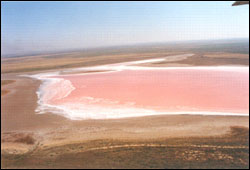Discovery points to new class of astronomical objects
Astronomers at Sweet Briar College and the Naval Research Laboratory (NRL) have detected a powerful new bursting radio source whose unique properties suggest the discovery of a new class of astronomical objects. The researchers have monitored the center of the Milky Way Galaxy for several years and reveal their findings in the March 3, 2005 edition of the journal, “Nature.”
Principal investigator, Dr. Scott Hyman, pr
An international team of astronomers using the world’s largest X-ray and optical telescopes have spotted the most distant massive object ever detected, a cluster of galaxies 9 billion light years distant from Earth.
The cluster of galaxies is so far away that the light detected by the team is much older than the Earth itself. The galaxy cluster, if it is even still there, would be at least 11 billion years old now. “By capturing this ancient, 9-billion-year-old light, we
In a new and novel study, scientists are looking to nature — specifically, to ants, bees and viruses — for ways to improve human collaboration during disaster relief efforts.
At the center of the scientists’ sights are a sub-group of their own species — specifically, civil engineers, who historically have had a limited role in such efforts, especially those involving critical physical infrastructures.
Supported by a five-year $2.37 million grant from the Nationa
Physicians have long been puzzled by a condition called intracranial arterial dolichoectasia, in which the larger arteries of the brain become elongated and misshapen. Typically, it has been considered a complication of atherosclerosis (“hardening of the arteries”), and not directly life-threatening. However, there is recent evidence that people with dolichoectasia are more likely to have aortic aneurysms, a potentially fatal weakening of the main artery that carries blood out from the heart
Many implications seen for biomedical research
The human brain is estimated to contain 100 billion neurons (the number 1 followed by eleven zeros). Because a typical neuron forms ~1,000 synaptic connections to other neurons, the total number of synapses in the brain is estimated to be 100 trillion (the number 1 followed by 14 zeros). The thin projections from neurons that form connections with each other (axons and dendrites) can be thought of as the biological “wiring” of the br

Micro-organisms in salt lakes produce chlorinated air pollutants
Salt lakes have a greater impact on climate change than was previously understood. This has been established by scientists from the UFZ Centre for Environmental Research (Umweltforschungszentrum Leipzig-Halle) together with colleagues from Austria, Russia and South Africa. They found evidence that bacteria in salt lakes produce substances which act as greenhouse gases and destroy the ozone layer. These substances a